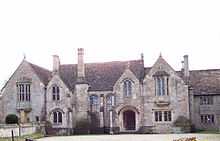Great Chalfield Manor

Great Chalfield Manor is an English country house at Great Chalfield, near Bradford-on-Avon, Wiltshire.
The house is a moated manor house built around 1465–1480 for Thomas Tropenell, a modest member of the landed gentry who made a fortune as a clothier. The independent hall, lit on both sides, is flanked by unusually symmetrical gabled cross wings, with oriel windows and lower gabled porches in the inner corners, in the north-facing former entrance court, for which the richest effects were reserved. Its external symmetry, unusual for its date, is superficial.[1] The intimately connected parish church, largely rebuilt by Tropnell, also faces into the court, which was formerly entered obliquely through a gatehouse in the west wing; Nicholas Cooper observes of the church that "the probable need to pass through the house's forecourt in order to reach it neatly demonstrates the community of secular and religious authority".[2] Part of a moat survives, but the forecourt has been opened up to the outside in a manner that changes its original inward-facing aspect.[3]

It was altered substantially (with some of the original character lost) after the Neale family commissioned the architect Thomas Larkin Walker, a pupil of Pugin, to carry out a detailed survey of the manor in 1836; though his restoration proposals of 1837 were never carried out, the house was reduced and in particular, the great hall, adapted as a farmhouse, lost its ornate ceiling, with only one of the original bosses surviving.
Externally there is a garden with four "tree houses", groups of four clipped yews that have grown together and been hollowed out inside to allow one to walk through. A feature of the church is the unusual "bellcote", a stone belfry built on to the gable peak.
The house and garden were purchased by George Fuller MP (of Neston Park) in the early 1900s, and restored and furnished between 1905 and 1911 by his fourth son, Major Robert Fuller, under the guidance of Sir Harold Brakspear. The restoration included a sympathetic garden design by Alfred Parsons. Robert Fuller gave the property to the National Trust in 1943, and it is open to the public.[4] Robert Floyd, grandson of Robert Fuller, and his family live here and manage the property for the Trust. Tours of the house are at fixed times and visitors are escorted by a guide. The historic Tropenell Cartulary is still kept at the house.

Film industry
The house and grounds have hosted the film industry since the end of the 20th century.
They were used for Wives and Daughters in 1999, the BBC television adaptation of Elizabeth Gaskell's novel, as Hamley Hall, the country house of a squire.[5]
They were later used for location filming of the 2008 film version of the historical novel The Other Boleyn Girl, and some scenes of the 2008 BBC Television adaptation of Tess of the d'Urbervilles.[6] Scenes for the BBC's Tudor-era historical TV serial Wolf Hall were filmed there in 2014.[7]
References
- ↑ Nicholas Cooper, Houses of the Gentry 480-1680 1999:60, floorplan fig.39, 61, 64.
- ↑ Cooper 1999:64.
- ↑ A point made by Cooper 1999:61.
- ↑ "Manor House". Robert & Patsy Fuller. Retrieved 30 July 2009.
- ↑ "Wiltshire on film". BBC Online. Retrieved 26 Jan 2015.
Wives and Daughters: Dyrham Park, NR Chippenham and Great Chalfield Manor.
- ↑ "Behind the scenes". National Trust. Retrieved 2008-04-16.
- ↑ Frith-Salem, Benjamin (20 January 2015). "Wolf Halls: take a look inside the properties where the new BBC series is filmed". BBC History Magazine. Retrieved 25 January 2015.
External links
| Wikimedia Commons has media related to Great Chalfield Manor. |
- Great Chalfield Manor information at the National Trust
- Great Chalfield Manor – Patsy & Robert Floyd
- Heritage Register of Parks and Gardens of Special Historic Interest: Great Chalfield Manor
- Great Chalfield church
- Behind the scenes gallery – images of Great Chalfield Manor and Lacock Abbey from the 2008 film, The Other Boleyn Girl, National Trust
- Map sources for Great Chalfield Manor
Coordinates: 51°22′05″N 2°12′11″W / 51.368°N 2.203°W
- "Being to the manor born". Bath Chronicle. October 29, 2008. p. 46. Description of manor, church and landscape.